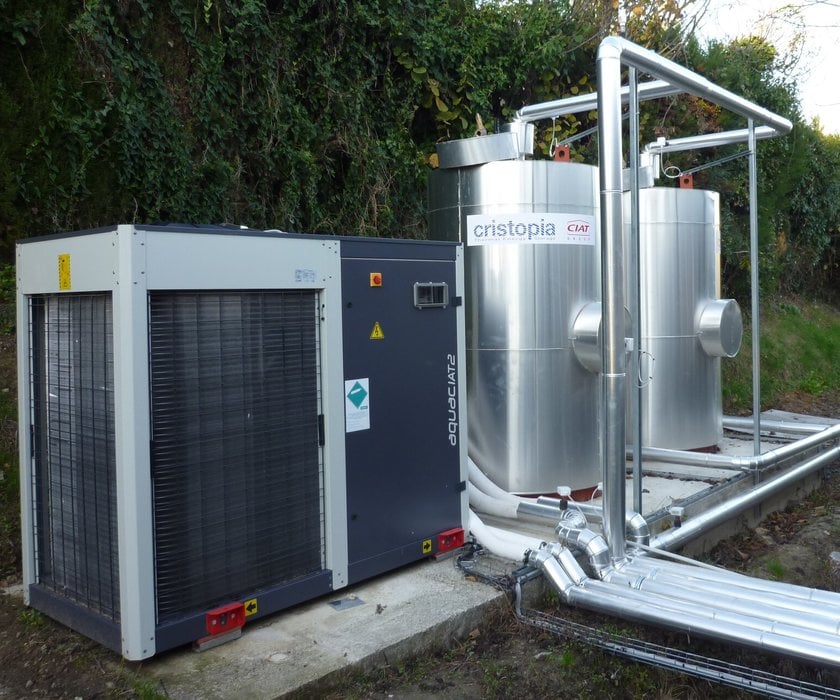www.industrymiddleeast.com
15
'11
Written on Modified on
A new system demonstrator in the CRISTOPIA building from the CIAT Group in Vence
CIAT Group, through its subsidiary CRISTOPIA Energy Systems has designed and implemented a HYSYS and Energy Unit system demonstrator with a STL thermal energy storage by CRISTOPIA in its new renovated buildings in Vence in the South of France. This "showroom" shows a typical operational facility to customers, integrators, consultants or other businesses which have refrigeration requirements higher than 500 kW, mainly for facilities in commercial sector. The whole Energy Unit is controlled by a Cristo'Control2, Comfort Unit as well as the double flow unit are managed by an Easy CIATControl.

HYSYS is a modular system, a combination of optimized products, aiming at preserving the quality of indoor air, human comfort and energy optimization in buildings.
Energy Unit is a system combining storage and low power energy generation technologies to provide hot and cold water at the lowest cost and limit environmental impacts.
Operational since June 2011, the facility includes an Aquaciat heat pump (Cooling power 61 kilowatts, Heating power 50 kilowatts for an absorbed power of 21 kW) with a CRISTOPIA cold storage system, a Cristo'Control2 smart regulation and control system, a double flow air handling unit Floway, CIAT comfort units (Coadis2, Coadis Comfort, Major line,....) and a precision air conditioner module Expair for the computer room.
The cold storage principle consists in storing the refrigeration energy when the demands of the buildings are low, mostly at night. By leveling the cooling production over 24 hours, the costs of energy consumption are reduced and the equipments are better sized.
This Vence facility is used by CRISTOPIA as an experimental platform for the MINOSTOC research project conducted in partnership with PROMES laboratory, the University of Pau and the Design and Engineering Office ACD2 (project co-financed by OSEO, the PACA region and partners). This project aims to increase heat transfer in the nodules by adding mineral fillers.
The coolant used is Greenway, a "green" fluid mainly composed of 1.3 Propanediol produced from 100% vegetable and renewable resources. Its energy and carbon footprint is twice lower than that of MEG / MPG products (mono ethylene or propylene glycol mono), derived from petroleum resources whose cost will continue to increase.
Cristo'Control2, the real brain of the Energy Unit, controls all the parameters to optimize the overall energy efficiency of the Energy Unit throughout the year. The supervision of the facility is provided locally (by the touch screen of the Cristo'Control2 panel) or remotely. This is usually managed by the maintenance company or any other body chosen by the owner of the facility (in our case the facility is supervised by CRISTOPIA in the same configuration as a client).The remote monitoring is done through a WAN modem connected to the client’s Ethernet or an ADSL modem (requires ADSL at the customer’s site).The remote monitoring on the website www.cristocontrol.com allows to supervise and analyze the facility operations in real time as well as on the medium and long term. Preventive maintenance is preferred by tracking the operation parameter drifts. The chances of curative intervention are thus reduced, operation costs as well and the quality of the service is improved. Moreover, in the long-term remote monitoring will make it possible to adapt the control strategies according the changes in the demands or the new energy prices.
CRISTOPIA’s cold storage system by Phase Change Material (PCM) is coupled to the building air conditioning and heating system to allow for a large enough cooling demand to empty both 2 m3 tanks simultaneously over one day or 220 kWh in total. Each tank contains 2,450 nodules with about 1000 liters of MCP per tank.
The instruments set up in the Cristo'Control2 (2 electromagnetic flowmeters, a heat meter on the desuperheater to prepare the ECS, an electric meter, 10 temperature sensors, a pressure sensor) are used to issue charge /discharge reports for each STL tank, to compare the power and temperature levels in storage, to automatically manage the authorized operating modes and to control the refrigeration generation network. Other functions are available such as alarms and faults transfer, remote monitoring, installation viewing, and the management of components status and operating parameters in real time by reporting the information on GTC / GTB (via RS422 / 485 - Modbus RTU) or by accessing the curves via a web browser

